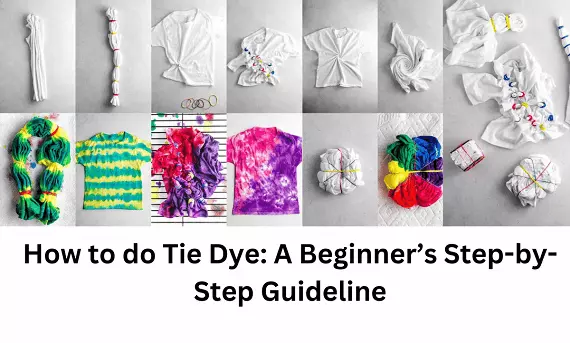Numerous creative techniques are utilized to enhance the fabric of garments. Tie-dye is one of the popular methods for creating stunning and vibrant clothing by blending various colors in unexpected and delightful patterns. This type of dyeing fabric is super popular these days. In this article, we present How to Do Tie Dye: A Beginner’s Step-by-Step Guideline.
What is Tie Dye?
The process of crafting a design by binding or securing specific areas of fabric with thread or other materials, followed by immersing the entire cloth in dye to achieve the intended pattern, is known as tie-dye. During this process, the dye doesn’t seep into the naturally bound parts. Still, the rest of the fabric absorbs the color, resulting in a lovely and eye-catching design where dyed and undyed sections blend.

How To Do Tie Dye Step By Step Guide?
The art of textile decoration, specifically tie-dye, has a rich history spanning various countries. Through this method, intricate patterns and vibrant colors are crafted onto fabric using a unique bonding process, resulting in beautiful and captivating designs that evoke a sense of wonder. Here’s a step-by-step guide to preparing for this charming art:
Preparing Your Fabric:
Before dyeing, it’s essential to thoroughly wash the chosen fabric to remove any starch or stains, ensuring an even color distribution. You can achieve this by boiling the material in a mixture of 8% baking soda, 4% soap, and 2% soda in hot water for 30 minutes. Afterward, rinse with ample water, dry, and iron the cloth.
Tie Dye Design Selection:
Mark the areas on your fabric where you intend to create the design using a pencil. The design should align with the intended use of the material, such as sarees, clothing pieces, or home décor items. Once the method is selected, tie the fabric in small bundles using various materials like yarn or rope.
Suitable Fabrics for Tiedye:
Natural fiber fabrics like cotton, linen, silk, and rayon are most suitable for the tie-dye method, resulting in exquisite outcomes. However, this method has also been adapted for synthetic fiber fabrics through chemical processes. If you want to know more you can click this Youtube link here.
Art Techniques for Making Tie Dye Designs:
Tie-dye encompasses several art techniques that offer versatility in creating designs. These techniques mainly depend on two factors:
- Different Bonding Methods
- Application of Dye
1) Different Bonding Methods:
Tie-dye employs various methods of bonding to create diverse designs. Five noteworthy tying methods include:
(i) Use Glue on Fabric:
This method involves using glue to create designs without the need for threads or ropes. The fabric is folded lengthwise and knotted at specific points. After weaving, it is dipped in the chosen dye. When the knots are undone after drying, the middle part of the knots retains its original color, resulting in unique designs.
(ii) Folding:
This method entails folding the fabric either horizontally or vertically and securing folds with ropes or threads at regular intervals. When creating designs with different colors, start with light colors before using darker ones to avoid color bleeding.
(iii) Quadrangle Method:
This technique involves dividing the fabric into two parts and each part into four to create corners. These corners are securely tied with threads or ropes and then dipped into dye. Multiple colors can be used, but each color must be applied before the previous one dries.
(iv) Using Different Objects:
To create varied designs, objects like stones, pebbles, coins, wood, buttons, grains, or pulses are placed on marked areas of the fabric, which are then tightly tied along the folds with threads. This method yields diverse designs, such as round, square, barfi, or elongated patterns.
(v) Design by Stitching:
This method involves drawing the desired design on the fabric, such as leaves or flowers, and then using needle and thread to create running stitches along the marked lines. The tie-dye method offers an artistic and versatile way to decorate fabric, allowing for a wide range of creative expressions.
Once the black stitching is completed, it’s essential to pull the thread’s starting and ending points delicately. By tugging the thread’s end, the fabric will form folds according to the design. This action creates charming, attractive waves along the design’s edges, and it should be repeated as needed.
2) Application of Dye
Typically, natural and synthetic dyes can be used to color the fabric, with artificial colors being the common choice. However, in our country, the following dyes are currently used for tie-dye, such as Prussian blue, Napasol, Indigo, Sulphur, and Katy, along with natural dyes. Here’s a description of the application method for VAT colors in tie-dye:
VAT Color Application Method:
- Mix 4 to 6 drops of hydros per color.
- Combine three to four tolas of soda and twenty times the cloth’s water.
- Mix the color with hot water and boil it.
- Add hard soda to the hot water.
- Stir for 4 to 5 minutes to ensure even coloring. Turn the fabric to cover the entire surface.
- After the material has cooled, wash it thoroughly.
- Remove the ties after the fabric has dried and iron it.
Advantages of the Tie Dye Method:
- The creativity of this method allows for the creation of new designs each time, even with the same binding techniques.
- It enables adults to express their creativity at home.
- This method can produce a wide range of industrial products at low cost and with minimal effort.
- It requires little space and can even be used to rejuvenate old clothing.
- Both natural and synthetic dyes can be easily employed.
- It has the potential to address various issues, such as unemployment and the economic well-being of the country.
- Creating unique combinations of colors on the same fabric is straightforward through this method.
Disadvantages of the Tie Dye Method:
- The process can be time-consuming when working with various types of art materials.
- Significant amounts of dye may be wasted when using multiple dyes on the same fabric.
- If the binding loosens for any reason, the dye can seep and affect the design’s outcome. Assessing the design’s success is only possible after untying.
- If the dye isn’t properly set during the process, the colors may fade quickly, rendering the fabric unwearable.
- Availability of specific colors may be limited when needed in this method.
Conclusion
Tie-dye is a vibrant and creative way to make an outfit more attractive. By following the guidelines above, you can learn the basic steps to start your tie-dye journey. If you have the basic concept of tie-dye, and know the basic steps, anyone can do this kind of design on clothes, and be subliminal. I’m sure people who are into tie and dye will find the article super helpful for starting a new business.
- You may love to read: What is Lab dip in the Textile Industry?
- Basic Anatomy of Reactive dye


